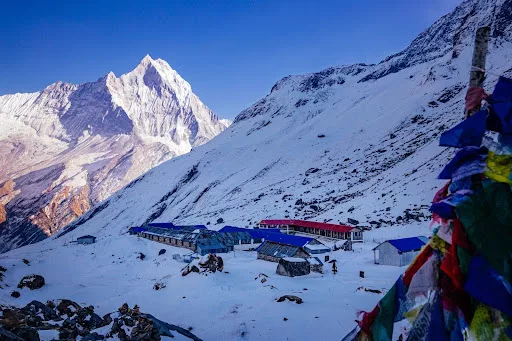The Annapurna Base Camp Trek, which is tucked away in the heart of the Himalayas, offers a captivating voyage through some of the world’s most breathtaking natural settings. This famous trip is a dream come true for hikers, environment enthusiasts, and adventure seekers. We will cover all the information you require to organize your experience with the “Annapurna Base Camp Trek,” the crown gem of the Annapurna region, in this extensive guide.
It’s crucial to comprehend the Annapurna region’s amazing beauty and abundant biodiversity before starting the hike. Because of its varied geography, this region is well known for having a variety of landscapes to explore, including alpine meadows, glacial moraines, and lush subtropical woods.
Location and Geography:
The Annapurna Base Camp, often known as the ABC, is located in the Annapurna Conservation Area’s Annapurna Sanctuary. This area is in north-central Nepal, not far from Pokhara, a bustling metropolis.
Annapurna Massif:
The tenth-highest peak in the world, Annapurna I (8,091 meters) is part of the Annapurna Massif. Trekkers can witness the magnificence of these towering peaks as they traverse across this dramatic setting.
Plant and Animal Life:
Trekking through a variety of environments allows you to see a wide range of wildlife, such as the Himalayan tahr, pika, and other bird species. Rhododendron, oak, and bamboo grow in the lush woodlands, producing a kaleidoscope of hues and fragrances.
An Important Points of the Annapurna Base Camp Trek
The captivating Annapurna Base Camp Trek leads you to the foot of the renowned Annapurna I. This hike is well-known for its varied environments, cross-cultural encounters, and breathtaking vistas of the mountains. Let’s examine the main features of the hike:
Duration:
Depending on the route used and the trekker’s pace, the average Annapurna Base Camp Trek takes seven to twelve days to finish. It’s critical to factor in enough time for acclimatization and sightseeing.
Distance:
Depending on the exact route, the walk covers a total of 110 to 115 kilometers (68 to 71 miles) in total.
Difficulty level:
Due to its moderate difficulty level, both novice and seasoned hikers can complete the trail. Nonetheless, it’s imperative to be psychologically and physically ready for the difficulties of high-altitude hiking.
Best time:
The best seasons to go trekking are from March to May in the spring and from September to November in the fall. Clear skies, comfortable temperatures, and flowering rhododendron woods can all be found throughout these months.
Permits:
The Trekkers’ Information Management System (TIMS) card and the Annapurna Conservation Area Permit (ACAP) are required to hike in the Annapurna region. You can obtain these permissions in Pokhara or Kathmandu.
Selecting Your Path
The range of options available for the Annapurna Base Camp Trek is among its most thrilling features. Every path offers stunning landscapes and distinctive experiences. Here are a few well-liked route choices:
The classic route:
The most popular route is the Classic Route, which passes through Ghorepani and Poon Hill. It passes through lovely rhododendron forests, and one of the highlights is the sunrise vista from Poon Hill.
The Sanctuary Trek:
A more intense alpine experience by a direct path to Annapurna Base Camp.
Trekking the Mardi Himal:
This less-traveled path offers breathtaking vistas of Machapuchare and Mardi Himal.
Jhinu Danda Hot Springs:
While traveling to the base camp, take this detour and unwind in the natural hot springs.
What to Anticipate: The Trek Schedule
An itinerary for the Annapurna Base Camp Trek might resemble this:
Day 1: Pokhara to Kathmandu
After reaching Kathmandu, fly domestically to Pokhara, which serves as the entrance to the Annapurna region.
Day 2: Tikhedhunga to Pokhara (via Nayapul)
Arrive at Nayapul by car, then begin your hike to Tikhedhunga. The walk winds past terraced farms and quaint communities.
Day 3: Ghorepani to Tikhedhunga
The hike continues through verdant forests and tiny villages to Ghorepani, where Poon Hill offers stunning sunset views.
Day 4: Tadapani to Ghorepani
Hike to Poon Hill early in the morning to see the captivating sunrise. After that, hike through stunning rhododendron forests to Tadapani.
Day 5: Chhomrong to Tadapani
Climb to Chhomrong, a Gurung settlement with breathtaking views of Machapuchare and Annapurna South, after descending to the Kimrong Khola.
Day 6: Bamboo to Chhomrong
Go down to the Chhomrong Khola, cross a suspension bridge, and climb up to Bamboo, where dense bamboo trees envelop you.
Day 7: Deurali to Bamboo
Before arriving in Deurali, the hike goes by Dovan and the Himalayan Hotel. This section provides distinctive vistas of Hinku Cave.
Day 8: Annapurna Base Camp (ABC) to Deurali
The most looked forward to the day! After traveling to Machapuchare Base Camp (MBC), the trail leads to Annapurna Base Camp, where breathtaking vistas of the mountains await you.
Day 9: Bamboo to ABC
Return to Bamboo by descending through the same breathtaking scenery.
Day 10: Jhinu Danda to Bamboo
Proceed downhill to Jhinu Danda for a well-earned rest and relaxation in the natural hot springs.
Day 11: Returning to Pokhara from Jhinu Danda to Nayapul
Drive back to Pokhara after your trek to Nayapul.
Day 12: Go back to Chengdu
Take a flight from Pokhara back to Kathmandu, where you can do some last-minute shopping or explore the city.
Highlights of Culture
In addition to its natural splendor, the Annapurna Base Camp Trek offers a wealth of cultural activities. You will come across a variety of ethnic populations along the route, such as the Gurung and Magar people. Experience their customs and warmth, and learn about local life by touring charming villages like Ghandruk and Chhomrong.
The Enchantment of Views at Dawn and Dusk
The stunning views of the sunrise and sunset can be found in the Annapurna region. One of the most famous sunrise views in the Himalayas may be seen by following the traditional route up Poon Hill. Witnessing the Annapurna Massif come to life at first light is an incredibly enchanting sight.
The Magnificence of Machapuchare
In the Annapurna region, the Fish Tail Mountain, also known as Machapuchare, is a revered summit. Unclimbed and shaped like a double summit, it’s a must-see on the hike. One of the journey’s highlights is the vista of Machapuchare from both Annapurna Base Camp and Machapuchare Base Camp (MBC).
Packing Necessities
It’s essential to pack carefully if you want your hike to be safe and enjoyable. The following are some necessities to include in your backpack:
Trekking equipment: includes comfortable backpacks, trekking poles, and sturdy hiking boots.
Clothes: The trick is to layer. For the chilly evenings, bring warm, moisture-wicking apparel; for the day, bring light, breathable clothing.
A high-quality sleeping bag and pad are essential for staying warm and cozy in teahouses throughout the journey.
Toiletries: A tiny towel, wet wipes, and toilet paper are among the essentials.
First Aid Kit: a complete kit for managing minor wounds and symptoms associated with altitude.
Water Purification: To guarantee safe drinking water, use a water purifier or purification tablets.
Electronics: Because power outlets are sometimes scarce, carry a portable charger for your gadgets.
Flashlight and headlamp: necessary for traversing trails and teahouses after dark.
Equipment for Photography: If you enjoy taking pictures, don’t forget to bring your camera and additional batteries.
Documents and Permits: Store your travel documents, identity, and permits in a waterproof pouch.
Recognize the Signs of Altitude Sickness
The possibility of altitude sickness is one of the main difficulties associated with trekking in the Annapurna region. Hikers at higher altitudes may get Acute Mountain Sickness (AMS). It’s critical to properly acclimate and be aware of the symptoms, which might include headache, nausea, and dizziness, in order to reduce this danger.
The Significance of Tea Rooms
The entire Annapurna Base Camp Trek path is dotted with teahouses. Trekking is now easier to reach and more convenient thanks to these modest lodges that provide simple lodging and meals. Trekkers can relax in comfortable lodgings, eat hot meals, and converse with locals. It’s important to remember that teahouse lodgings vary widely in terms of comfort, so expect minimal facilities.
Conscientious Hiking and Preservation of the Environment
Trekking in the Annapurna region is an important way to protect its biodiversity and natural beauty as it is a designated conservation area. Observe these responsible hiking recommendations:
Remove Trash: When you get to a lower height, take all of your waste with you and dispose of it correctly.
Respect Local Culture: Pay attention to the traditions and practices of the area. Prior to shooting pictures of individuals, residences, or places of worship, get permission.
Use Reusable Water Bottles: Reusable water bottles and water purifying techniques can reduce the amount of plastic trash generated.
Buy locally produced goods and stay in tea shops run by the communities you pass through to show your support for local businesses.

Going on a Trek with a Porter and Guide
While individual trekking is possible, hiring a local guide and porter is a popular choice among trekkers. Porters help carry your bulky bag so you can enjoy the walk without as much strain, while guides offer insightful commentary on the history, geography, and culture of the area. Employing locals helps the Annapurna region’s residents maintain their standard of living.
Safety Points to Remember: Throughout your expedition, safety should be your first concern. Here are some pointers to guarantee a secure travel:
Appropriate Acclimatization: Increase your altitude gradually and give your body enough time to adjust.
Keep Yourself Hydrated: To avoid being dehydrated at high elevations, drink lots of water.
Respect the Weather: Adjust your plans for safety based on the conditions and be ready for changing weather.
Stay Aware: Pay attention to trail conditions and weather forecasts, and heed local guidance.
Emergency Contacts: Keep a list of emergency contacts with you, and let someone at home know where you’re going.
Conclusion: a once-in-a-lifetime adventure
For anyone seeking the ideal fusion of scenic splendor, cultural immersion, and strenuous physical exertion, the Annapurna Base Camp Trek presents an experience of a lifetime. You’ll build once-in-a-lifetime experiences as you travel through enchanted forests, charming villages, and stunning mountain scenery.
To guarantee a secure and enjoyable trip, schedule your Annapurna Base Camp Trek with “Annapurna Base Camp Trek”. You’ll learn the genuine definition of adventure as you go into the heart of the Himalayas and get enthralled with the Annapurna region’s unadulterated beauty. This hike is sure to be an unforgettable experience, regardless of your level of experience.


